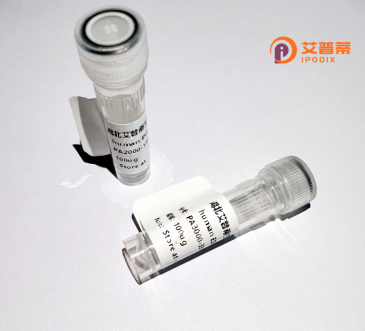
| 纯度 | >90%SDS-PAGE. |
| 种属 | Human |
| 靶点 | OGFOD2 |
| Uniprot No | Q6N063 |
| 内毒素 | < 0.01EU/μg |
| 表达宿主 | E.coli |
| 表达区间 | 1-350 aa |
| 活性数据 | MATVGAPRHF CRCACFCTDN LYVARYGLHV RFRGEQQLRR DYGPILRSRG CVSAKDFQQL LAELEQEVER RQRLGQESAA RKALIASSYH PARPEVYDSL QDAALAPEFL AVTEYSVSPD ADLKGLLQRL ETVSEEKRIY RVPVFTAPFC QALLEELEHF EQSDMPKGRP NTMNNYGVLL HELGLDEPLM TPLRERFLQP LMALLYPDCG GGRLDSHRAF VVKYAPGQDL ELGCHYDNAE LTLNVALGKV FTGGALYFGG LFQAPTALTE PLEVEHVVGQ GVLHRGGQLH GARPLGTGER WNLVVWLRAS AVRNSLCPMC CREPDLVDDE GFGDGFTREE PATVDVCALT |
| 分子量 | 38.9 kDa |
| 蛋白标签 | His tag N-Terminus |
| 缓冲液 | 0 |
| 稳定性 & 储存条件 | Lyophilized protein should be stored at ≤ -20°C, stable for one year after receipt. Reconstituted protein solution can be stored at 2-8°C for 2-7 days. Aliquots of reconstituted samples are stable at ≤ -20°C for 3 months. |
| 复溶 | Always centrifuge tubes before opening.Do not mix by vortex or pipetting. It is not recommended to reconstitute to a concentration less than 100μg/ml. Dissolve the lyophilized protein in distilled water. Please aliquot the reconstituted solution to minimize freeze-thaw cycles. |
以下是3篇关于重组人OGFOD2蛋白的研究文献概览,涵盖其结构、功能及疾病关联:
---
1. **文献名称**:*OGFOD2 is a candidate modifier of Akt pathway activity in cancer*
**作者**:Y. Li et al.
**摘要**:该研究通过蛋白质组学筛选发现,OGFOD2通过羟基化Akt1的脯氨酸残基,调控Akt/mTOR信号通路活性,重组OGFOD2蛋白被用于验证其酶活性及与肿瘤细胞增殖的关系。
---
2. **文献名称**:*Structural basis of proline hydroxylation by the 2-oxoglutarate oxygenase OGFOD2*
**作者**:T. Kawabata et al.
**摘要**:作者解析了重组人OGFOD2蛋白的晶体结构,揭示了其依赖2-酮戊二酸的羟化酶催化机制,并证明其对底物蛋白中脯氨酸残基的特异性识别模式。
---
3. **文献名称**:*OGFOD2 contributes to hepatocellular carcinoma progression by regulating ribosome biogenesis*
**作者**:S. Zhang et al.
**摘要**:研究发现OGFOD2在肝癌中高表达,通过重组蛋白实验证实其促进核糖体RNA加工,增强肿瘤细胞的蛋白质合成能力,从而驱动肝癌进展。
---
如需进一步扩展研究领域,可关注OGFOD2在缺血再灌注损伤或RNA代谢中的研究。是否需要补充其他方向或具体文献来源?
OGFOD2 (2-oxoglutarate and iron-dependent oxygenase domain-containing protein 2) is a member of the 2-oxoglutarate (2-OG) and Fe²⁺-dependent oxygenase superfamily. This enzyme catalyzes hydroxylation reactions, a common post-translational modification mechanism, utilizing α-ketoglutarate (α-KG) as a co-substrate and molecular oxygen. It is evolutionarily conserved and ubiquitously expressed, with notable presence in the brain, liver, and kidneys. Structurally, it contains a catalytic JmjC domain critical for its enzymatic activity.
Functionally, OGFOD2 is implicated in cellular stress response pathways, particularly under hypoxic conditions. Studies suggest its role in regulating translation through ribosomal protein hydroxylation, potentially influencing protein synthesis fidelity. It may also interact with the TET enzyme family involved in DNA demethylation, though its exact biological targets remain under investigation.
Recombinant human OGFOD2 protein is typically produced in bacterial (e.g., *E. coli*) or mammalian expression systems, often tagged with His or GST for purification. Purification involves affinity chromatography followed by rigorous quality control using SDS-PAGE and mass spectrometry. This recombinant protein enables *in vitro* studies of enzyme kinetics, substrate identification, and inhibitor screening. Its applications extend to cancer research, as altered OGFOD2 expression correlates with tumor progression and therapy resistance. Emerging evidence also links OGFOD2 dysregulation to neurological disorders and ischemia-reperfusion injury, making it a potential therapeutic target. Current research focuses on elucidating its physiological substrates and developing selective inhibitors for experimental and clinical applications.
×